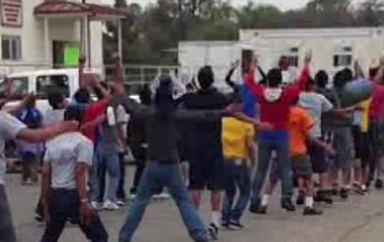 PORT HUENEME, Calif.: The converted warehouse on a Southern California military base that once housed sailors preparing to deploy overseas is now plastered with posters of X-Men and Green Lantern and filled with migrant teens eating applesauce and chatting about World Cup soccer.
PORT HUENEME, Calif.: The converted warehouse on a Southern California military base that once housed sailors preparing to deploy overseas is now plastered with posters of X-Men and Green Lantern and filled with migrant teens eating applesauce and chatting about World Cup soccer.
The cavernous facility at Naval Base Ventura County known as “Building 267” is one of three shelters set up by federal government officials to house hundreds of Central American children caught entering the country illegally following a surge in border crossing. And while beds in the sleeping quarters are still crisply cornered, the blankets are now pink and turquoise, with teddy bears on top of some of the pillows.
During a tightly controlled tour in Port Hueneme, a government official said the number of teens housed at the 42,000 square foot facility could more than triple to 575 soon. The official could not be named as a condition of the visit, and no photos or video were allowed.
Federal authorities have also set up a shelter at a military base in Texas and are planning another for Oklahoma to cope with what they have described as an “urgent humanitarian situation.” More than 47,000 children, mostly from Central America, have been apprehended at the Mexican border since the start of the budget year in October.
In California, bunk beds and extra dining tables await the newcomers. Dirt soccer fields were created for outdoor play, and many are excited to watch World Cup matches on television, a shelter supervisor said.
Reporters were not allowed to speak with the children, who range in age from 13 to 17.
During their stay, the teens were learning long division in math class and drawing in art. Lunch was pizza bread, Caesar salad and applesauce served on brown disposable plates and eaten under white tents outdoors.
Each child is assigned a bunk bed and locker. Girls and boys are housed separately in sparsely decorated quarters hung with pictures made by the children or of superheroes. In the classroom areas, posters feature the president and American icons such as Rosa Parks.
The facility has air conditioning but officials haven’t needed to use it yet, and children bathe in individual showers.
After their arrest on the border, the children are transferred to HHS’ custody and placed at a shelter until case workers find a relative or sponsor to care for them and ensure they attend immigration court hearings on government efforts to deport them.
Martha Arevalo, executive director of the Central American Resource Center in Los Angeles, said children fleeing dire situations and enduring a perilous journey to the United States should be housed in warm, personal settings where they feel safe _ not a detention-style or military environment. -AP






